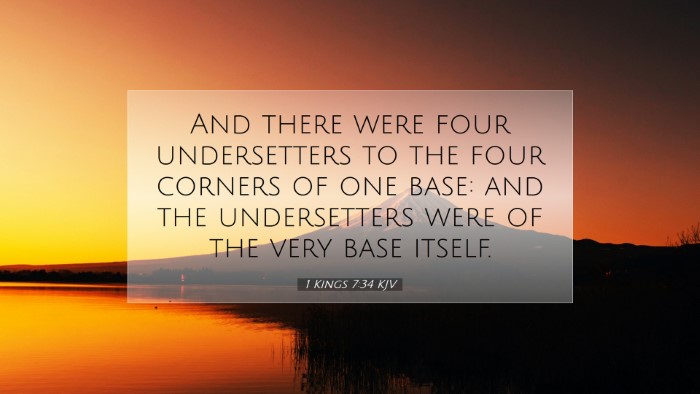Commentary on 1 Kings 7:34
Verse: "And there were four under setters to the pillars, and the rests of the chapiters that were upon the pillars: and the rests were rounded, and they were in the knops." (1 Kings 7:34)
Introduction
The verse 1 Kings 7:34 encapsulates crucial elements of the architectural magnificence of Solomon’s temple, emphasizing the intricate designs of the pillars which bear immense theological and symbolic significance. This commentary distills insights from various public domain sources, integrating perspectives offered by Matthew Henry, Albert Barnes, and Adam Clarke to provide a comprehensive understanding of this scripture.
Contextual Significance
Understanding the context of 1 Kings 7 is essential. This chapter details Solomon’s Temple’s construction, highlighting the materials, craftsmanship, and artistry involved. Solomon’s investment of resources and the involvement of skilled artisans demonstrates the priority he placed on worship and the representation of God's glory.
Architectural Details
-
Pillars:
In 1 Kings 7:34, the mention of “pillars” speaks to the grandeur of the temple. These pillars signify stability and strength, holding up not only the physical structure but also symbolizing God’s enduring presence among His people. Matthew Henry notes that these pillars were not merely functional but served as an expression of the magnificence and holiness of the temple.
-
Under Setters:
The term "under setters" refers to the bases or supports of the pillars. Adam Clarke emphasizes that each component was meticulously crafted to ensure that the pillars stood firm. This reflects a deeper spiritual truth: the foundation of faith must be strong to withstand the tests of time.
-
Chapiter Rests:
The chapiters (the ornamental tops of the pillars) add an artistic flourish, suggesting that worship is not just about functionality but also about beauty and reverence. Albert Barnes points out that these designs invite the worshipper’s awe and contemplation, illustrating that beauty in worship is a reflection of God’s character.
-
Rounded Rests:
The "rounded" nature of the rests indicates sophistication and artistry in design. This intentional curvature symbolizes grace, perhaps reflecting God’s favor resting upon His people. Matthew Henry suggests that the design of the temple serves as a reminder of the smooth and perfect nature of divine grace extended to humanity.
Theological Implications
The details provided in this verse unveil profound theological implications beyond architectural significance. The elaboration on the pillars and their bases serves as a metaphor for the believer’s relationship with God.
-
Stability in Faith:
The pillars symbolize the believer’s faith, which must be firmly established upon the teachings and truths of Scripture. As Adam Clarke reminds us, just as a physical structure requires solid support, so too does faith thrive on understanding and adhering to God’s word.
-
Beauty in Holiness:
The artistry embodied in the chapiters emphasizes that holiness has an inherent beauty. Albert Barnes highlights that the temple was designed to inspire reverence, insinuating that worship and life dedicated to God should reflect beauty and not just morality.
-
God’s Dwellings:
Ultimately, this passage reminds the believer that God desires to dwell among His people. The grandeur of the temple illustrates the lengths to which God goes to ensure His presence is among those who seek Him. Matthew Henry posits that every detail in the temple points to God’s initiative of grace, inviting us into relationship.
Practical Applications
This verse challenges pastors, students, and theologians to reflect on the following practical applications:
-
Excellence in Service:
As Solomon dedicated immense resources to build the temple, so should the Church dedicate skill, time, and talent to serve the Lord. Every aspect of ministry should reflect excellence, embodying the beauty found in devotion.
-
Building Strong Foundations:
In personal faith and communal church life, it is vital to establish strong foundations. Regular study of scripture and prayer are the supports that hold up the faith during turbulent times.
-
Celebration of Beauty in Worship:
The beauty of God’s creation and His holiness should inspire creative expressions in worship. This could include music, art, and architecture that lead the congregation to a deeper understanding of God’s nature.
Conclusion
1 Kings 7:34 serves as a remarkable insight into the grandeur of Solomon’s temple while providing rich theological and practical lessons for contemporary believers. By examining the architectural details, we uncover deeper truths about faith, beauty, and the nature of God. Through reflections gleaned from Matthew Henry, Albert Barnes, and Adam Clarke, we are called to embody faith that is not only functional but also beautiful, demonstrating the glory of God in every aspect of life.


